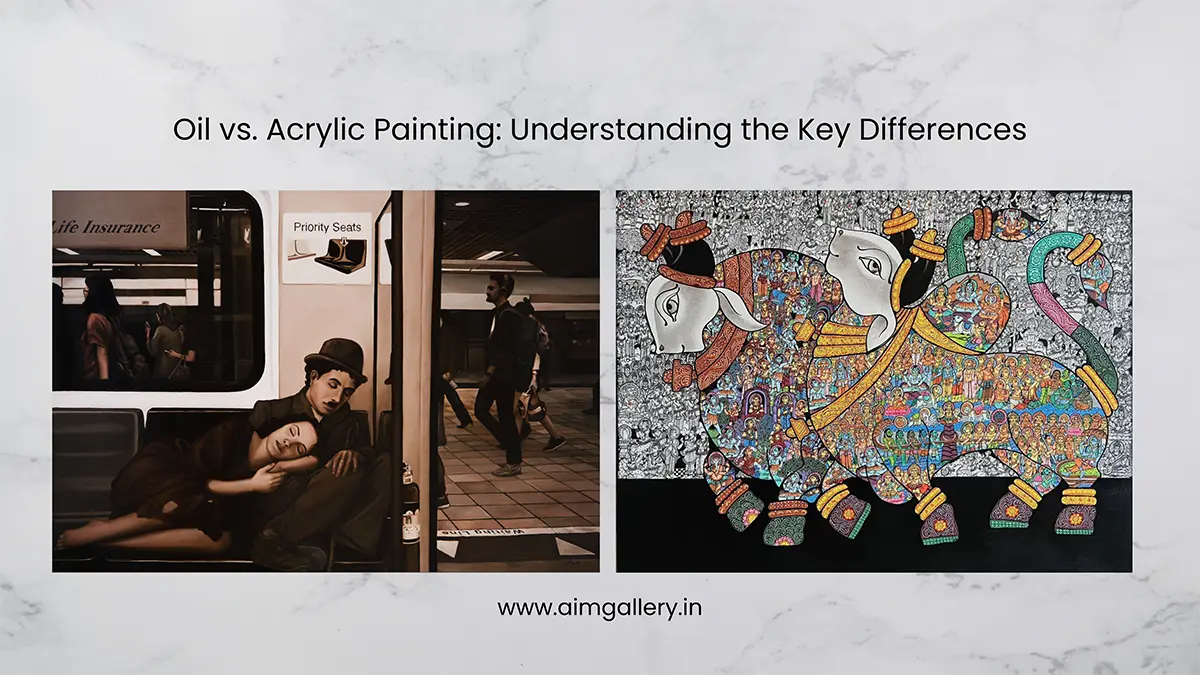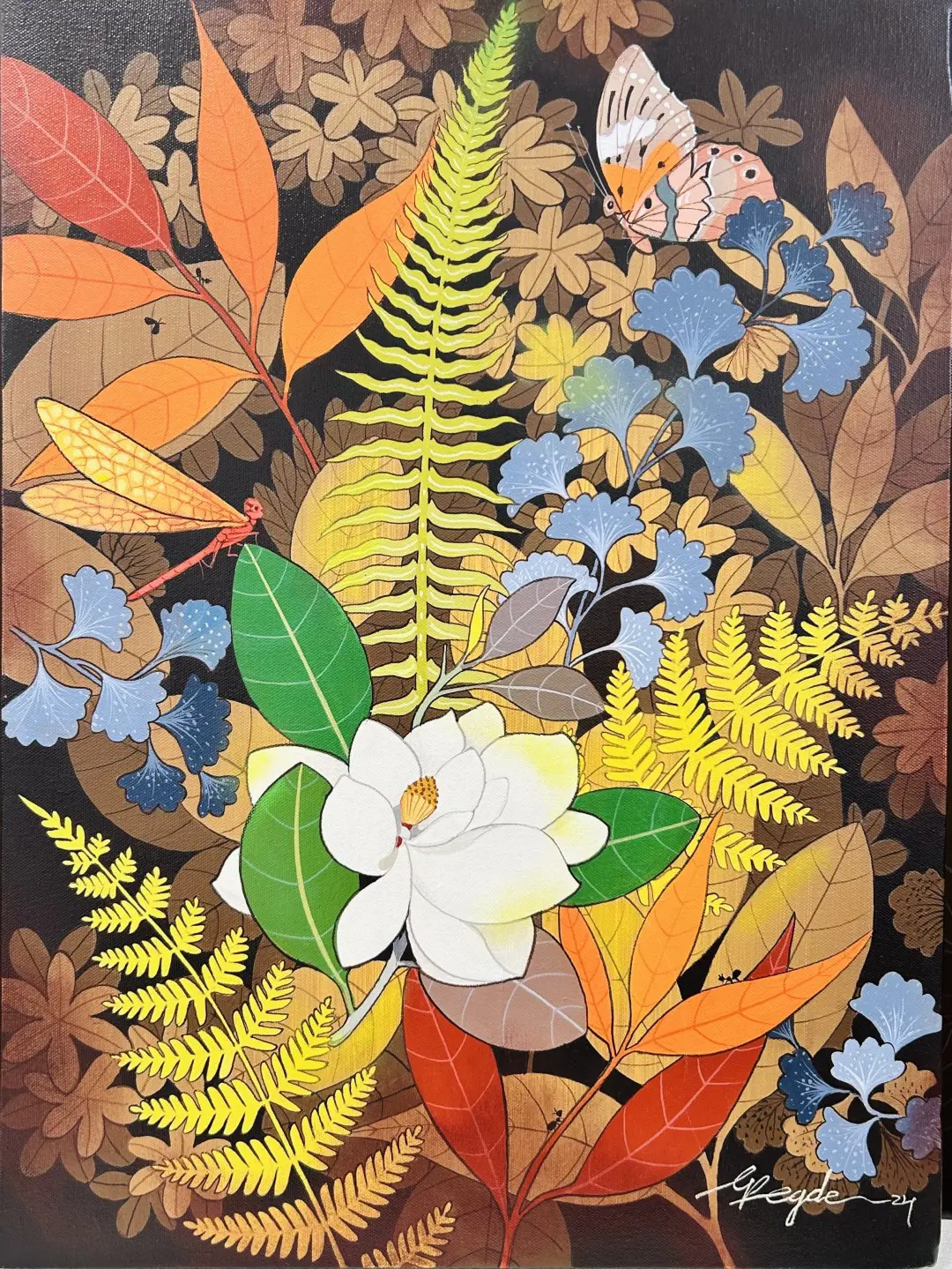
Oil vs. Acrylic Painting: Understanding the Key Differences
Painting is a form of artistic expression that has inspired humans for centuries, with different mediums offering unique textures, drying times, and working techniques. Among the most popular mediums, oil and acrylic paints have distinct characteristics that make them suitable for different styles, preferences, and artistic intentions. Whether you’re a seasoned artist or a beginner exploring the world of painting, understanding the key differences between oil and acrylic paints can help you make informed decisions about which medium suits your needs.
In this blog, we’ll see the fundamental differences between oil and acrylic painting, exploring the properties, and techniques of each medium.
1. Composition and Origin
The first major difference between oil and acrylic paints lies in their composition.
Oil Painting



(Oil Paintings by Pardeep Singh, Arpana Caur and Pradeep Kumar)
Oil painting is a traditional art form that uses pigments mixed with a drying oil, most commonly linseed oil, to create artwork. The oil in the paint acts as a binder, holding the pigment together and providing a rich, glossy finish once dried. The medium allows for smooth blending and layering due to its slow drying time, which can range from several days to weeks, depending on the thickness of the paint and environmental conditions.
Historically, oil painting has been a favorite among classical and Renaissance artists like Leonardo da Vinci, Rembrandt, and Van Gogh. Its ability to produce detailed, luminous, and textured effects makes it ideal for realistic and expressive works. The viscosity and opacity of oil paints enable artists to create depth and richness in their artworks that are unmatched by other mediums.
Acrylic Painting


(Acrylic paintings by Bhaskar Rao and Sanket Viramgami)
Acrylic painting, in contrast, is a more modern medium that uses pigments suspended in an acrylic polymer emulsion. This water-based paint is known for its versatility and quick drying time, often becoming touch-dry within minutes to a few hours. Unlike oil paints, acrylics can be used straight from the tube or thinned with water for a more transparent effect, similar to watercolors.
Since its introduction in the mid-20th century, acrylic painting has become popular due to its flexibility and adaptability to various techniques and surfaces. Artists can achieve a range of effects, from thick, impasto textures to smooth, transparent washes. Acrylics are also highly durable and resistant to fading, making them suitable for artists who want to work quickly or experiment with different styles and techniques.
2. Drying Time
One of the most notable differences between oil and acrylic paints is the drying time.
Oil paints dry slowly, taking several hours to days depending on the thickness of the paint and the environmental conditions. This slow drying time allows artists to work with the paint for extended periods, blending colors and creating smooth transitions. The ability to rework and adjust the paint over time is a significant advantage for artists who prefer to work methodically and in layers.
Acrylic paints dry much faster, often within minutes to a few hours. This quick drying time is beneficial for artists who like to work quickly or in multiple layers without having to wait long periods between applications. However, the rapid drying time can also be a drawback for those who want to blend colors on the canvas, as the paint may dry before achieving the desired effect.
3. Techniques and Application
The difference in drying times and composition leads to varied techniques and applications for oil and acrylic paints.
Oil Painting Techniques:

(Oil Painting by Samir Mohanty)
Blending: The slow drying time of oil paints makes them ideal for blending, allowing artists to create smooth gradients and transitions between colors.
Glazing: Oil paints can be used in a technique called glazing, where transparent layers of paint are applied over a dry underpainting. This technique creates depth and luminosity in the artwork.
Impasto: Oil paints can be applied thickly to create a textured surface, a technique known as impasto. The thick layers of paint hold their shape and add a three-dimensional quality to the painting
Acrylic Painting Techniques:

(Acrylic painting by Bijita Sharma)
Layering: Acrylics dry quickly, making them perfect for layering without the need to wait long periods between applications. This technique is useful for building up color and texture.
Wash: Acrylics can be thinned with water to create a wash effect, similar to watercolor. This technique is useful for creating translucent layers and subtle color shifts.
Dry Brushing: Acrylics can be used for dry brushing, where a small amount of paint is applied to a dry brush and then lightly dragged across the surface, creating a textured, streaky effect.
4. Flexibility and Versatility
Another key difference between oil and acrylic paints is their flexibility and versatility in terms of surfaces and finishes.
Oil paints can be applied to a variety of surfaces, including canvas, wood, and even metal. However, they are less flexible than acrylics and can crack over time if applied too thickly or if the painting is exposed to extreme temperature changes. Oil paints also require a primed surface, usually with a gesso layer, to prevent the oil from seeping into the support and causing deterioration.


(Oil Paintings by Mahesh Singh and Geeta Kumari)
Acrylics are extremely versatile and can be applied to a wide range of surfaces, including canvas, paper, wood, glass, and even fabric. They are more flexible than oil paints, making them less prone to cracking over time. Acrylics can also be used to achieve a variety of finishes, from matte to glossy, by adding different mediums.


(Acrylic paintings by S Kharat)
5. Clean-Up and Safety
The clean-up process and safety considerations differ significantly between oil and acrylic paints.
Cleaning up after using oil paints requires solvents like turpentine or mineral spirits to remove the paint from brushes and palettes. These solvents can be hazardous if not used in a well-ventilated area, as they emit strong fumes and can be harmful if inhaled or if they come into contact with the skin.
Acrylics are water-based, making clean-up easy and safe. Brushes, palettes, and other tools can be cleaned with just soap and water. Acrylic paints are generally considered non-toxic and are a safer option for artists, particularly those who work in small or enclosed spaces.
6. Longevity and Durability
The longevity and durability of a painting can be influenced by the type of paint used.
Oil paintings have a long history of durability, with many masterpieces still in excellent condition centuries after they were created. However, oil paintings are more susceptible to yellowing and cracking over time, especially if not properly cared for. Varnishing an oil painting can help protect it from environmental damage and preserve its colors.
Acrylic paintings are highly durable and resistant to yellowing, cracking, and fading. The acrylic polymer used in the paint forms a flexible film as it dries, which helps the paint adhere to the surface and withstand changes in temperature and humidity. Acrylic paintings can last for many years with minimal maintenance, making them a popular choice for contemporary artists.
7. Cost and Accessibility
Finally, the cost and accessibility of oil and acrylic paints can be a deciding factor for many artists.
Oil paints are often more expensive than acrylics, particularly when purchasing high-quality pigments. The cost of additional materials like solvents, mediums, and varnishes can also add up. However, the rich, luminous finish and the ability to create intricate details and textures make oil paints worth the investment for many artists.
Acrylics are generally more affordable and accessible, making them an attractive option for beginners and artists on a budget. They also require fewer additional materials, as they can be thinned with water and cleaned up easily. The affordability and versatility of acrylic paints make them a popular choice for schools, workshops, and artists who like to experiment with different techniques.
Conclusion


(Oil and Acrylic paintings by Ganapati Hegde)
Both oil and acrylic paints offer unique advantages and challenges, making them suitable for different artistic approaches. Oil paints provide a rich, luminous finish, with the ability to blend and layer colors over time. They are ideal for artists who enjoy working slowly and methodically, with a focus on texture and detail. Acrylic paints, on the other hand, offer versatility, quick drying times, and ease of use, making them perfect for artists who like to work quickly and experiment with different surfaces and techniques.
Ultimately, the choice between oil and acrylic paints depends on your personal preferences, artistic goals, and the type of work you want to create. Many artists choose to work with both mediums, exploring the unique qualities of each to expand their creative possibilities. Whether you’re drawn to the timeless appeal of oil paints or the modern versatility of acrylics, both mediums offer endless opportunities for artistic expression.






